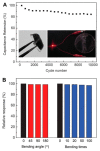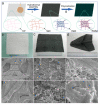Review on Graphene-, Graphene Oxide-, Reduced Graphene Oxide-Based Flexible Composites: From Fabrication to Applications
- PMID: 35160958
- PMCID: PMC8838127
- DOI: 10.3390/ma15031012
Review on Graphene-, Graphene Oxide-, Reduced Graphene Oxide-Based Flexible Composites: From Fabrication to Applications
Abstract
In the new era of modern flexible and bendable technology, graphene-based materials have attracted great attention. The excellent electrical, mechanical, and optical properties of graphene as well as the ease of functionalization of its derivates have enabled graphene to become an attractive candidate for the construction of flexible devices. This paper provides a comprehensive review about the most recent progress in the synthesis and applications of graphene-based composites. Composite materials based on graphene, graphene oxide (GO), and reduced graphene oxide (rGO), as well as conducting polymers, metal matrices, carbon-carbon matrices, and natural fibers have potential application in energy-harvesting systems, clean-energy storage devices, and wearable and portable electronics owing to their superior mechanical strength, conductivity, and extraordinary thermal stability. Additionally, the difficulties and challenges in the current development of graphene are summarized and indicated. This review provides a comprehensive and useful database for further innovation of graphene-based composite materials.
Keywords: composite; flexible devices; graphene; graphene oxide; reduced graphene oxide.
Conflict of interest statement
The authors declare no conflict of interest.
Figures

















Similar articles
-
Graphene-Based Flexible and Stretchable Electronics.Adv Mater. 2016 Jun;28(22):4184-202. doi: 10.1002/adma.201504245. Epub 2016 Jan 5. Adv Mater. 2016. PMID: 26728114
-
Transparent Conductive Electrodes Based on Graphene-Related Materials.Micromachines (Basel). 2018 Dec 26;10(1):13. doi: 10.3390/mi10010013. Micromachines (Basel). 2018. PMID: 30587828 Free PMC article. Review.
-
Nanocellulose-graphene composites: Preparation and applications in flexible electronics.Int J Biol Macromol. 2023 Dec 31;253(Pt 3):126903. doi: 10.1016/j.ijbiomac.2023.126903. Epub 2023 Sep 14. Int J Biol Macromol. 2023. PMID: 37714239 Review.
-
Advanced Carbon for Flexible and Wearable Electronics.Adv Mater. 2019 Mar;31(9):e1801072. doi: 10.1002/adma.201801072. Epub 2018 Oct 9. Adv Mater. 2019. PMID: 30300444 Review.
-
Sensor to Electronics Applications of Graphene Oxide through AZO Grafting.Nanomaterials (Basel). 2023 Feb 24;13(5):846. doi: 10.3390/nano13050846. Nanomaterials (Basel). 2023. PMID: 36903724 Free PMC article. Review.
Cited by
-
Research on Graphene and Its Derivatives in Oral Disease Treatment.Int J Mol Sci. 2022 Apr 25;23(9):4737. doi: 10.3390/ijms23094737. Int J Mol Sci. 2022. PMID: 35563128 Free PMC article. Review.
-
Recent Progress in Multifunctional Graphene-Based Nanocomposites for Photocatalysis and Electrocatalysis Application.Nanomaterials (Basel). 2023 Jul 7;13(13):2028. doi: 10.3390/nano13132028. Nanomaterials (Basel). 2023. PMID: 37446544 Free PMC article. Review.
-
Materials Nanoarchitectonics at Dynamic Interfaces: Structure Formation and Functional Manipulation.Materials (Basel). 2024 Jan 4;17(1):271. doi: 10.3390/ma17010271. Materials (Basel). 2024. PMID: 38204123 Free PMC article. Review.
-
Waterborne Eco-Sustainable Sol-Gel Coatings Based on Phytic Acid Intercalated Graphene Oxide for Corrosion Protection of Metallic Surfaces.Int J Mol Sci. 2022 Oct 10;23(19):12021. doi: 10.3390/ijms231912021. Int J Mol Sci. 2022. PMID: 36233325 Free PMC article.
-
Conversion of Carbon Dioxide into Chemical Vapor Deposited Graphene with Controllable Number of Layers via Hydrogen Plasma Pre-Treatment.Membranes (Basel). 2022 Aug 18;12(8):796. doi: 10.3390/membranes12080796. Membranes (Basel). 2022. PMID: 36005711 Free PMC article.
References
-
- Jalili R., Aboutalebi S.H., Esrafilzadeh D., Shepherd R.L., Chen J., Aminorroaya–Yamini S., Konstantinov K., Minett A.I., Razal J.M., Wallace G.G. Scalable one–step wet–spinning of graphene fibers and yarns from liquid crystalline dispersions of graphene oxide: Towards multifunctional textiles. Adv. Funct. Mater. 2013;23:5345–5354. doi: 10.1002/adfm.201300765. - DOI
-
- Lundstedt A., Papadakis R., Li H., Han Y., Jorner K., Bergman J., Leifer K., Grennberg H., Ottosson H. White–Light Photoassisted Covalent Functionalization of Graphene Using 2–Propanol. Small Methods. 2017;1:1700214. doi: 10.1002/smtd.201700214. - DOI
-
- Li H., Papadakis R., Jafri S.H.M., Thersleff T., Michler J., Ottosson H., Leifer K. Superior adhesion of graphene nanoscrolls. Commun. Phys. 2018;1:44. doi: 10.1038/s42005-018-0043-2. - DOI
-
- Chabot V., Higgins D., Yu A., Xiao X., Chen Z., Zhang J. A review of graphene and graphene oxide sponge: Material synthesis and applications to energy and the environment. Energy Environ. Sci. 2014;7:1564–1596. doi: 10.1039/c3ee43385d. - DOI
Publication types
Grants and funding
LinkOut - more resources
Full Text Sources

